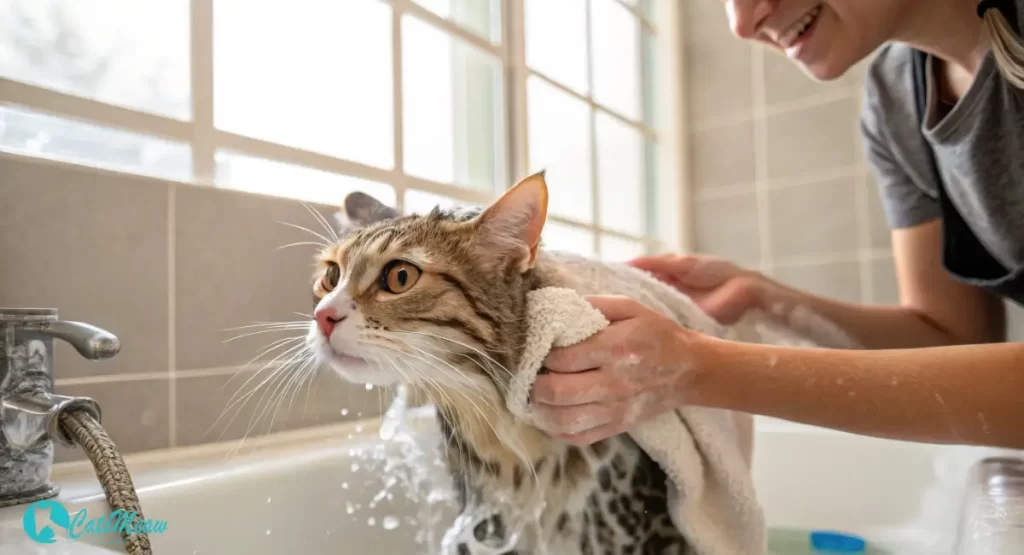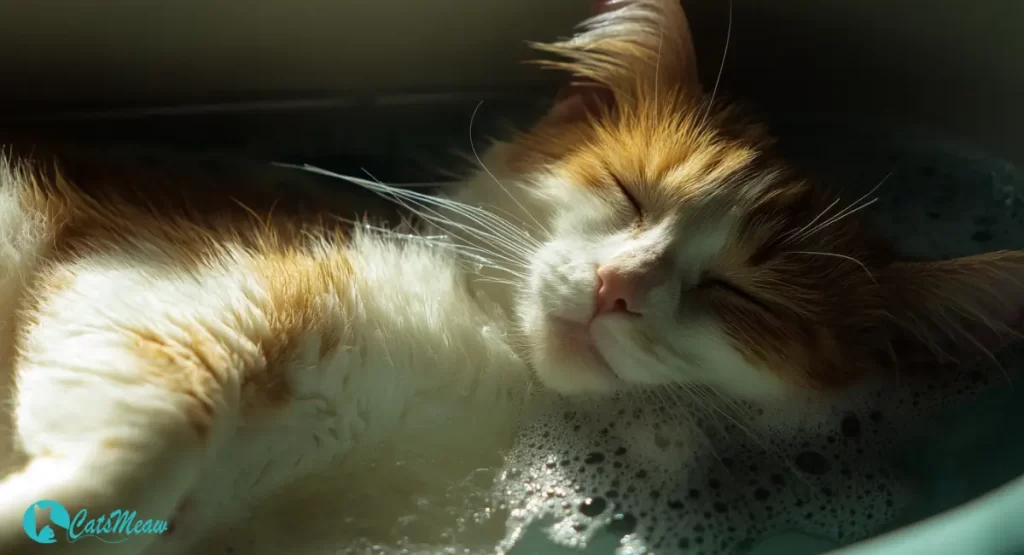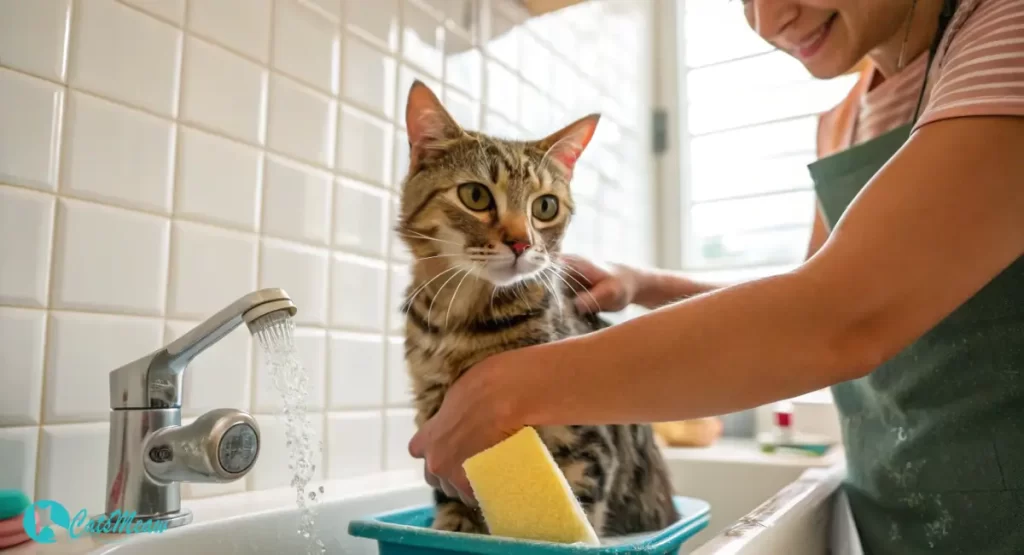Most cat owners have experienced that moment of dread when their beloved feline needs a bath. Learning how to wash a cat often feels like preparing for an Olympic wrestling match, complete with scratches, yowls, and occasional defeat.
Although cats are typically excellent self-groomers, there are times when they need our help to get clean. Whether your cat had an unfortunate encounter with motor oil or simply needs a flea treatment, this guide will show you how to tackle bath time without turning it into a battle zone. In fact, with the right approach, you can transform this dreaded task into a manageable – and maybe even peaceful – experience.

Table of Contents
Understanding Your Cat’s Bath Behavior
Cats’ complex relationship with water stems from both their evolutionary history and physical makeup. Primarily, their ancestors lived in dry, arid environments, which means they never needed to develop swimming skills or comfort around water.
The physical reasons behind a cat’s water aversion are quite fascinating. Their fur absorbs water rather than repelling it, making them feel heavy and uncomfortable when wet. Furthermore, cats have sensitive whisker-like hairs all over their body that help them sense their environment, and getting these wet can disrupt their ability to navigate their surroundings.
A cat’s response to water often manifests through specific stress signals. These physical reactions include:
- Increased heart and respiratory rates
- Trembling and salivation
- Dilated pupils and flattened ears
- Crouching and leaning away from the stimulus
Notably, not all cats share the same level of water aversion. Some cats actually enjoy water, while others might tolerate warm water but dislike cold 2. This individual variation means that learning how to wash a cat requires understanding your specific pet’s comfort level.

Consequently, forcing a cat into water can trigger their natural stress response. When cats feel threatened or uncertain, they enter a ‘flight or fight’ mode. This explains why even the most docile cats might become defensive during bath time. Understanding these natural behaviors helps explain why getting silly cats clean isn’t always as straightforward as we might hope.
Essential Pre-Bath Preparation
Success in learning how to wash a cat starts with thorough preparation. Initially, gather all essential supplies within arm’s reach:
- Cat-specific shampoo (never use human products)
- Large towels for drying
- Non-slip mat for tub or sink
- Brush and comb
- Cotton balls for ear cleaning
- Rubber gloves
- Small cup or pitcher for rinsing
- Cat treats
Before running any water, trim your cat’s nails. This crucial step prevents accidental scratches and makes the experience safer for everyone involved. Next, brush your cat thoroughly to remove loose fur and tangles. Specifically, matted fur becomes worse when wet, making it nearly impossible to untangle after bathing.
Setting up the right environment plays a vital role in keeping silly cats clean. Place a non-skid surface in the sink or tub to help your cat feel secure. Additionally, ensure the room is warm and free from drafts. Fill the tub with approximately 4 inches of lukewarm water – just above your cat’s paws .
Timing matters significantly in bath preparation. Schedule the bath when your cat is naturally calm and tired, preferably after a play session. Moreover, recruit a helper if possible – managing four paws with two hands can be challenging.
Before starting, clean your cat’s ears with a cotton ball moistened with warm water, focusing only on visible parts. Remember to prepare treats nearby as rewards for cooperation.
How to Wash a Cat in 3-Minute Method
Speed and efficiency mark the difference between a successful cat bath and a chaotic splash fest. Following this three-minute method helps keep silly cats clean without prolonged stress.
Start by placing your cat in a dry sink or small basin. Primarily, cats feel less anxious in smaller spaces compared to large bathtubs. Following this, fill the container with about 3-4 inches of lukewarm water.
Begin wetting your cat from behind the ears down to the tail. Use a sprayer, cup, or your cupped hand to wet their underside.
Important: Keep water away from your cat’s ears, eyes, and nose to prevent potential infections.
Next, dilute the cat shampoo (1 part shampoo to 5 parts water). Gently massage the solution into your cat’s fur, working from neck to tail. Pay special attention to their ‘armpits’ and genital areas.
The most crucial step comes afterward – thorough rinsing. Even when you think all soap is gone, rinse once more. Shampoo residue can irritate your cat’s skin and attract dirt. Therefore, take extra care to check every nook and cranny.

For drying, wrap your cat in a warm towel and gently squeeze out excess water. Soon after, use a second dry towel for patting. If your cat tolerates it, a pet dryer on low heat can help finish the job.
Remember to reward your cat generously throughout the process. This positive reinforcement helps make future baths less stressful for both of you.
Conclusion
Bathing a cat might seem like a daunting task, though armed with the right knowledge and approach, this necessary grooming ritual becomes significantly more manageable. Understanding your cat’s natural instincts, coupled with proper preparation, transforms bath time from a potential crisis into a controlled situation.
Remember that each cat responds differently to water. Some might tolerate warm baths, while others need extra patience and reassurance. Sticking to the three-minute method keeps the experience brief yet effective, minimizing stress for both you and your feline friend.
Success lies in consistency and positive reinforcement. Regular treats, gentle handling, and a calm environment help build trust over time. Most importantly, maintaining your composure throughout the process signals to your cat that bath time isn’t a threat, making future grooming sessions progressively easier.
Rather than viewing cat bathing as a battle, consider it an opportunity to strengthen your bond with your pet. After all, a clean cat is a healthy cat, and your effort to keep silly cats clean shows just how much you care about their wellbeing.
FAQ
1- How do you wash a cat without it freaking out?
How to wash a cat without stressing it out? start by preparing everything in advance. Use a sink or a small tub with a non-slip mat and fill it with a few inches of lukewarm water. Keep the environment quiet and calm, speaking softly to reassure your cat. Gently wet its fur using a cup or a handheld sprayer on a low setting, avoiding the face. Use a cat-specific shampoo and rinse thoroughly. Dry your cat with a warm towel and reward it with treats. Keeping the process quick and stress-free will help prevent future anxiety.
2- How do you bathe a cat that hates being held?
If your cat dislikes being held, try bathing it in a confined space like a small tub or sink with a non-slip mat. Let your cat stand freely and gently pour water over its body instead of forcing it into the water. Use a washcloth for sensitive areas and a sprayer or cup to rinse. Keep movements slow and steady, and talk calmly to soothe your cat. Offering treats during and after the bath can create a positive association. If your cat is still too resistant, consider using cat-friendly wipes or dry shampoo as an alternative.
3- How do you give a mad cat a bath?
A mad cat may scratch or bite, so safety is key. Trim its nails beforehand and consider using a harness or a soft towel for gentle restraint. Keep the bath area enclosed to prevent escape. Use lukewarm water and avoid sudden movements. Wearing long sleeves and using gloves can help protect you. Work quickly but gently, using a cup to pour water and a soft cloth for the face. If your cat becomes too aggressive, it may be best to stop and try again later or use waterless alternatives.
4- How to calm a cat for a bath?
To calm a cat before a bath, start by tiring it out with playtime. Use calming techniques like gentle petting, a soothing voice, or feline pheromone sprays. Introduce the bathing area gradually, allowing your cat to explore before starting. Keep water at a comfortable lukewarm temperature and use slow, gentle movements. Have treats ready as positive reinforcement. If your cat remains anxious, consider using a damp washcloth or cat wipes instead of a full bath.
